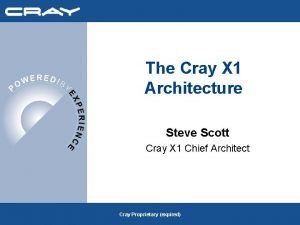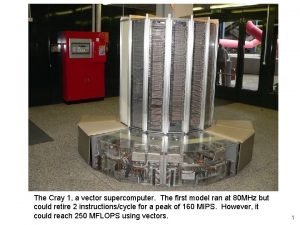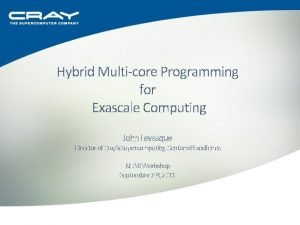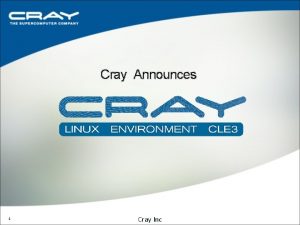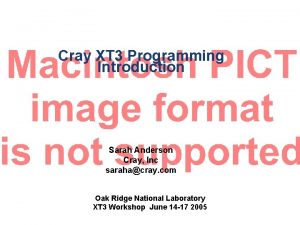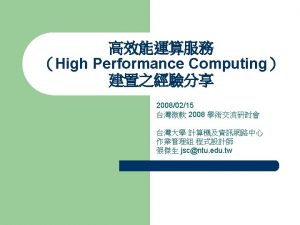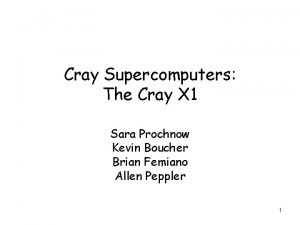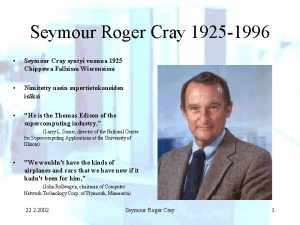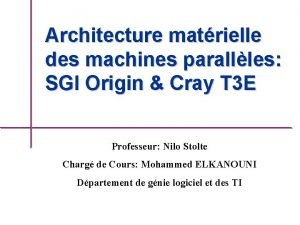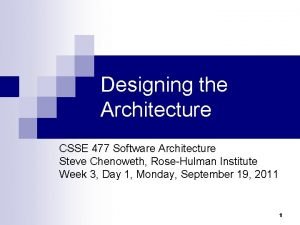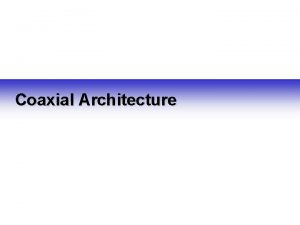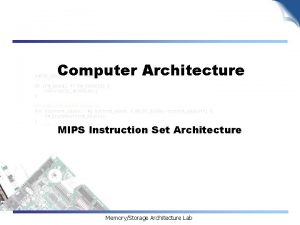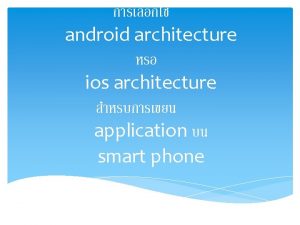The Cray X 1 Architecture Steve Scott Cray


































- Slides: 34

The Cray X 1 Architecture Steve Scott Cray X 1 Chief Architect Cray Proprietary (expired)

Cray’s Computing Vision Scalable High-Bandwidth Computing 2010 ‘Cascade’ ‘Black Widow 2’ 2006 Sustained Petaflops X 1 E 2004 Product Integration X 1 Red Storm Cray X 1 Overview 2006 2004 2005 RS ‘Strider 2’ ‘Strider 3’ Cray Proprietary (expired) ‘Strider X’ Slide 2

Cray X 1 Cray PVP T 3 E • Powerful vector processors • Very high memory bandwidth • Non-unit stride computation • Special ISA features • Extreme scalability • Optimized communication • Memory hierarchy • Synchronization features • Modernized the ISA • Improved via vectors Extreme scalability with high bandwidth vector processors Cray X 1 Overview Cray Proprietary (expired) Slide 3

Cray X 1 Instruction Set Architecture New ISA – – Much larger register set (32 x 64 vector, 64+64 scalar) All operations performed under mask 64 - and 32 -bit memory and IEEE arithmetic Integrated synchronization features Advantages of a vector ISA – Compiler provides useful dependence information to hardware – Very high single processor performance with low complexity ops/sec = (cycles/sec) * (instrs/cycle) * (ops/instr) – Localized computation on processor chip – large register state with very regular access patterns – registers and functional units grouped into local clusters (pipes) excellent fit with future IC technology – Latency tolerance and pipelining to memory/network very well suited for scalable systems – Easy extensibility to next generation implementation Cray X 1 Overview Cray Proprietary (expired) Slide 4

Not Your Father’s Vector Machine • New instruction set • New system architecture • New processor microarchitecture • “Classic” vector machines were programmed differently – Classic vector: Optimize for loop length with little regard for locality – Scalable micro: Optimize for locality with little regard for loop length • The Cray X 1 is programmed like a parallel microbased machine – Rewards locality: register, cache, local memory, remote memory – Decoupled microarchitecture performs well on short loop Cray X 1 Overview Cray Proprietary (expired) Slide 5

Cray X 1 Node P P P P $ $ $ $ M M M M mem mem mem mem IO IO 51 Gflops, 200 GB/s • Four multistream processors (MSPs), each 12. 8 Gflops • High bandwidth local shared memory (128 Direct Rambus channels) • 32 network links and four I/O links per node Cray X 1 Overview Cray Proprietary (expired) Slide 6

NUMA Scalable up to 1024 Nodes Interconnection Network • 16 parallel networks for bandwidth • Global shared memory across machine Cray X 1 Overview Cray Proprietary (expired) Slide 7

Designed for Scalability • Distributed shared memory (DSM) architecture – Low latency, load/store access to entire machine (tens of TBs) • Decoupled vector memory architecture for latency tolerance – Thousands of outstanding references, flexible addressing • Very high performance network – High bandwidth, fine-grained transfers – Same router as Origin 3000, but 16 parallel copies of the network • Architectural features for scalability – Remote address translation – Global coherence protocol optimized for distributed memory – Fast synchronization • Parallel I/O scales with system size Cray X 1 Overview Cray Proprietary (expired) Slide 8

Network Topology (16 CPUs) P M 0 Section 0 Cray X 1 Overview P P node 0 P M 15 M 1 P P P M 15 M 1 P M 0 P M 15 P M 0 P M 1 P M 0 P P M 15 M 1 node 2 node 3 Section 15 Section 1 Cray Proprietary (expired) Slide 9

Network Topology (128 CPUs) R R R R Cray X 1 Overview Cray Proprietary (expired) Slide 10

Network Topology (512 CPUs) one chassis Cray X 1 Overview Cray Proprietary (expired) Slide 11

Network Topology (1024 CPUs) one chassis Cray X 1 Overview Cray Proprietary (expired) Slide 12

Some Design Challenges • How do we tolerate ever growing memory latencies? • How do we support address translations and cache coherence with high bandwidth vector processors? Cray X 1 Overview Cray Proprietary (expired) Slide 13

Decoupled Vector Microarchitecture • Decoupled access/execute and decoupled scalar/vector • Scalar unit runs ahead, doing addressing and control – Scalar and vector loads issued early – Store addresses computed early, saved for later use – Operations queued and executed later when data arrives • Hardware dynamically unrolls loops – Scalar starts on next loop before current loop has completed – Memory pipeline stays full of requests – Special sync operations keep pipeline full, even across barriers This is key to making the system perform well on short loop nests Cray X 1 Overview Cray Proprietary (expired) Slide 14

Maintaining Decoupling Past Synchronization Points Msync control and data barrier: P 0 …. St Vx …. Msync …. Ld P 1 …. St Vx …. Msync …. Ld P 2 …. St Vx …. Msync …. Ld P 3 …. St Vx …. Msync …. Ld Want to protect against hazards, but not drain memory pipeline. Vector store addresses computed early (before data is available): – sent out to the shared L 2 cache, where it modifies cache state – later loads from other P chips can now be performed – loads only wait if there is a true conflict Cray X 1 Overview Cray Proprietary (expired) Slide 15

Address Translation • High translation bandwidth: – scalar + four vector translations per cycle per P chip • Remote (hierarchical) translation: – allows each node to manage its own memory (eases memory mgmt. ) – TLB only needs to hold translations for one node scales Cray X 1 Overview Cray Proprietary (expired) Slide 16

Cache Coherence • Global coherence, but only cache memory from local node – Supports SMP-style codes up to 4 MSPs – References outside this domain converted to non-allocate • Scalable codes use explicit communication anyway – Keeps directory entry and protocol simple – Significant reliability benefits for large scale systems • Explicit cache allocation control – Per instruction hints – Use non-allocating refs to avoid cache pollution • Coherence directory stored on the M chips (rather than in DRAM) – Low latency and really high bandwidth to support vectors • Factor of several hundred over typical DRAM-based directory Cray X 1 Overview Cray Proprietary (expired) Slide 17

Mechanical Design Cray Proprietary (expired)

Multi-Chip Module 8 - 7 S IBM IC’s & 80 Decoupling Capacitors 72 mm X 8. 3 mm 3832 LGA Pads on BSM 34, 000 C 4 Pads on TSM 173, 000 mm of Routing – a Routing Density of 3300 mm per Square cm Cray X 1 Overview 18 Plane Pairs of X & Y Routing in Ceramic Cray Proprietary (expired) 83 layer, Glass Ceramic/Copper Conductor/Mesh Construction Slide 19

Compliant Interconnect Resistance of 0. 015 m ohms @ 0. 75 amps 3832 Contacts on 1 -mm Spacing Force of 40 grams (153 kg per MCM) Alignment is by Socket Spring/Fence Centering Cray X 1 Overview Inductance of < 1. 5 n. H @ 500 -1000 MHz Cray Proprietary (expired) Compliance of 12 mils Non-Yielding Re-Mateable Interface (100 times) Slide 20

Printed Circuit Board 558 mm x 431 mm and 3. 5 mm 17, 000 Nets and 99, 000 Buried & Thru Vias 1 mm Via Pitch • Two Routes / Channel 3, 600, 000 mm of Routing (1500 mm per square cm) 34 layers - 16 Power and Ground, 16 Signal, & 2 Surface Cray X 1 Overview 3 mil Traces on 4 and 8 mil Pitch 100 W impedance - Differential 45 W impedance - Single Ended Cray Proprietary (expired) Distributes 2000 Amps DC Current Slide 21

Spray Cap Assembly Heat Flux of IC’s on the MCM are: 2 P Chip Heat Flux - 45 W/cm 2 E Chip Heat Flux - 15 W/cm IC Junction Temperature of 85 o C @ Heat Flux Density up to 70 W/cm 2 O-Ring Seal Flow Rate is 1 ml/w/min @ Pressure Differential of 25 psig Mixed Vapor Return Evaporation Efficiency Of ~ 25% Maintain Component Junction Temperatures @ 75 o C +/-10 o Cray X 1 Overview Fluid Inlet Fluorinert™ FC 72, the liquid coolant is atomized and sprayed onto the (ICs) to maintain a continuously wetted surface Cray Proprietary (expired) Slide 22

Power Converter Synchronous Rectification 1, 000 hour MTBF Input Voltage- 48 Volt • Electronic Inrush Control • Current-Share • Margins • Enable Features Conduction Cooled Power Density of 16 watts/in 3 Cray X 1 Overview 190 amp output current @ 1. 8 volts(125 amps @ 2. 5 -volt) with efficiencies of 80% at max. output Cray Proprietary (expired) Slide 23

Memory Daughter Card Forced Convection Cooled Via a Heat Spreader • (qja=16 C/W@1200 fpm) 16 RDRAM® (Rambus®) Memory Chips 1. 25 CFM of Air per Daughter Cards Support Multiple Memory Chip Densities Cray X 1 Overview Connects to the PCB Via a Custom 294 -Pin Connector Cray Proprietary (expired) Slide 24

System Packaging • LC Cabinets – – All System Heat is Rejected to Facility Water 1 to 16 Node Modules per LC Cabinet Up to 8 Cabinets, 512 CPUs, standard hypercube Up to 64 Cabinets, 4, 096 CPUs, mesh topology • AC Cabinets – All System Heat is Rejected to Facility Air – 1 to 4 Node Modules (16 CPUs) per AC Cabinet – Maximum 4 Cabinets, 64 CPUs • 50 Hz & 60 Hz Power Supported Cray X 1 Overview Cray Proprietary (expired) Slide 25

System Specifications • Power LC Cabinet AC Cabinet 82 KW, 208 v 3Ø 20 KW, 208 v 3Ø • Cooling LC Cabinet AC Cabinet 40 -45 GPM 2000 CFM • Footprint LC Cabinet AC Cabinet 43. 5 in x 84 x 82. 25 in 32 in x 48 in x 82 in • Weight LC Cabinet AC Cabinet Cray X 1 Overview 3500 lbs 1200 lbs Cray Proprietary (expired) Slide 26

Liquid Cooled Cabinet Cable Routing Card Cage & Connectors Router Modules Power Distribution Bus Node Modules Damper Doors Incoming Power Box Power Supplies Heat Exchanger Blower Assembly FC-72 Gear Pumps FC-72 Filters Cray X 1 Overview Cray Proprietary (expired) Slide 27

Air Cooled Cabinet Cable Routing Card Cage & Connectors Router Modules Node Modules Blower Assembly Heat Exchanger Incoming Power Box FC-72 Filters Power Supplies Cray X 1 Overview Cray Proprietary (expired) Slide 28

Node board Field-Replaceable Memory Daughter Cards Spray Cooling Caps CPU MCM 8 chips Network Interconnect PCB 17” x 22’’ Cray X 1 Overview Air Cooling Manifold Cray Proprietary (expired) Slide 29

Cray X 1 Node Module Cray X 1 Overview Cray Proprietary (expired) Slide 30

Node Module (Power Converter side) Cray X 1 Overview Cray Proprietary (expired) Slide 31

Cray X 1 Chassis Cray X 1 Overview Cray Proprietary (expired) Slide 32

64 Processor Cray X 1 System ~820 Gflops Cray X 1 Overview Cray Proprietary (expired) Slide 33

256 Processor Cray X 1 System ~3. 3 Tflops Cray X 1 Overview Cray Proprietary (expired) Slide 34
 Steve scott cray
Steve scott cray Vector supercomputer
Vector supercomputer Steve jobs steve wozniak and ronald wayne
Steve jobs steve wozniak and ronald wayne St mary cray primary
St mary cray primary Cray 1
Cray 1 Which feeding level represents the primary consumers
Which feeding level represents the primary consumers Cdc 6600
Cdc 6600 John levesque cray
John levesque cray Graham cray
Graham cray Graham cray
Graham cray St mary cray primary school
St mary cray primary school Hình ảnh bộ gõ cơ thể búng tay
Hình ảnh bộ gõ cơ thể búng tay Ng-html
Ng-html Bổ thể
Bổ thể Tỉ lệ cơ thể trẻ em
Tỉ lệ cơ thể trẻ em Chó sói
Chó sói Tư thế worms-breton
Tư thế worms-breton Chúa yêu trần thế
Chúa yêu trần thế Môn thể thao bắt đầu bằng từ chạy
Môn thể thao bắt đầu bằng từ chạy Thế nào là hệ số cao nhất
Thế nào là hệ số cao nhất Các châu lục và đại dương trên thế giới
Các châu lục và đại dương trên thế giới Công thức tính độ biến thiên đông lượng
Công thức tính độ biến thiên đông lượng Trời xanh đây là của chúng ta thể thơ
Trời xanh đây là của chúng ta thể thơ Cách giải mật thư tọa độ
Cách giải mật thư tọa độ 101012 bằng
101012 bằng Phản ứng thế ankan
Phản ứng thế ankan Các châu lục và đại dương trên thế giới
Các châu lục và đại dương trên thế giới Thể thơ truyền thống
Thể thơ truyền thống Quá trình desamine hóa có thể tạo ra
Quá trình desamine hóa có thể tạo ra Một số thể thơ truyền thống
Một số thể thơ truyền thống Bàn tay mà dây bẩn
Bàn tay mà dây bẩn Vẽ hình chiếu vuông góc của vật thể sau
Vẽ hình chiếu vuông góc của vật thể sau Thế nào là sự mỏi cơ
Thế nào là sự mỏi cơ đặc điểm cơ thể của người tối cổ
đặc điểm cơ thể của người tối cổ V cc cc
V cc cc
